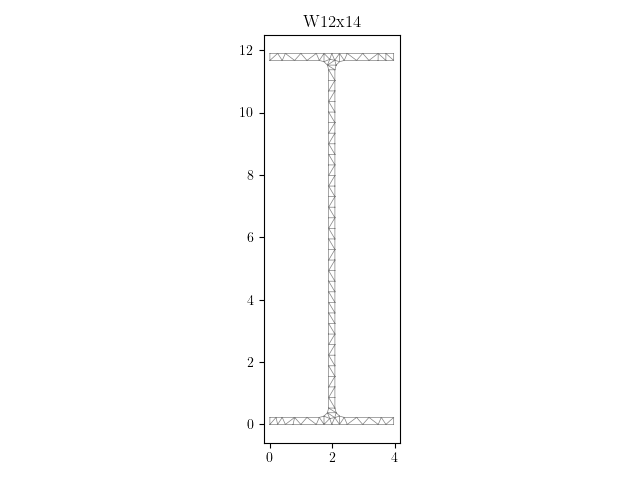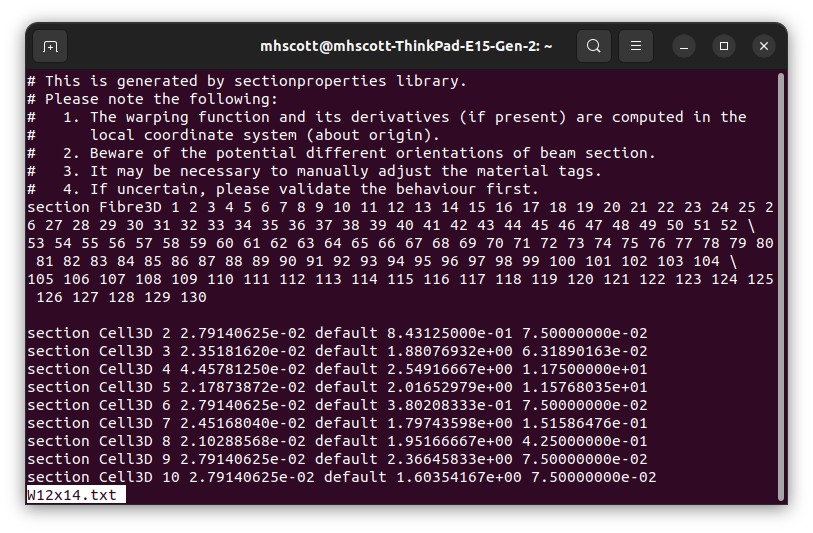OpenSees Cloud
OpenSees AMI
One Fiber at a Time
Original Post - 19 Jan 2025 - Michael H. Scott
Show your support at Buy Me a Coffee.
A few years after G3 became OpenSees, UCFyber became
XTRACT. In those
intervening years, to accommodate section data exported from UCFyber, we
added the
fiber
command to OpenSees, allowing you to add a single fiber
to a section based on the fiber’s (y,z) coordinates, area, and material
tag.
Several section analysis software packages have sprung up since XTRACT.
One package that recently caught my attention is
sectionproperties,
which uses finite element analysis to compute elastic and plastic
section properties.
As far as I can tell, you cannot use sectionproperties for general
moment-curvature analysis like you can with XTRACT or OpenSees. But
that’s not a big deal–what you really want out of sectionproperties is
the section discretization.
The sectionproperties package has a large section library. For example, you can easily create a wide flange section, e.g., a W12x14, including fillet rounds.
from sectionproperties.analysis import Section
from sectionproperties.pre.library import i_section
# W12x14
geom = i_section(d=11.9, b=3.97, t_f=0.225, t_w=0.2, r=0.3, n_r=4) # Four points along each fillet round
geom.create_mesh(mesh_sizes=0.5) # Maximum element size
sec = Section(geometry=geom)
sec.plot_mesh(title='W12x14',materials=False)
The resulting cross-section triangulation is shown below.

This is more fibers than necessary for most earthquake engineering
applications, but let’s go with it. There are several options in
sectionproperties to use a coarser mesh and to break sections up into
regions. You can also define arbitrary sections like you would using the
patch command in OpenSees.
For any section geometry, the coordinates and area of each fiber can be
saved to a file using the
to_fibre_section
function.
from sectionproperties.post.fibre import to_fibre_section
fiberfile = 'W12x14.txt'
to_fibre_section(geom, analysis_type="3D", save_to=fiberfile)
The format of the saved file is compatible with
suanPan,
an open source
FEA package similar to OpenSees. After the header notes and the section
information, there is a list of fibers, one per line, each line
beginning with section Cell3D followed by an id, the section area, the
material tag (default in this case), then the x and y coordinates of the
fiber.

Reading this information into an OpenSees fiber section is
straightforward. Just note that x from sectionproperties is z in
OpenSees.
E = 29000
matTag = 8
ops.uniaxialMaterial('Elastic',matTag,E)
ops.section('Fiber',1)
with open(fiberfile) as file:
for line in file:
if line.startswith('#'):
continue
line = line.rstrip()
line = line.split(' ')
if line[0] == 'section' and line[1] == 'Cell3D':
A = float(line[3])
z = float(line[5])
y = float(line[6])
ops.fiber(y,z,A,matTag)
Note that I’m managing the material definition directly in OpenSees,
ignoring the default material id in the fiber section output. You can
also define different materials in sectionproperties and have the
material id exported with each fiber.
And if you need to rotate asymmetric sections, e.g., a channel, you can adjust the local axes of the element, e.g., via the vector in the x-z plane for frame elements. You never need to explicitly rotate section coordinates.
There’s probably better ways to get fiber information out of
sectionproperties. And there’s probably more efficient ways to parse the
section data file. But this approach works and conveys how to define an
OpenSees fiber section one fiber at a time from the highly sophisticated
sectionproperties Python package.
If you need yet another reason to switch from OpenSees.exe (Tcl) to
OpenSeesPy, easy integration with
sectionproperties
is it. Give the package a try!